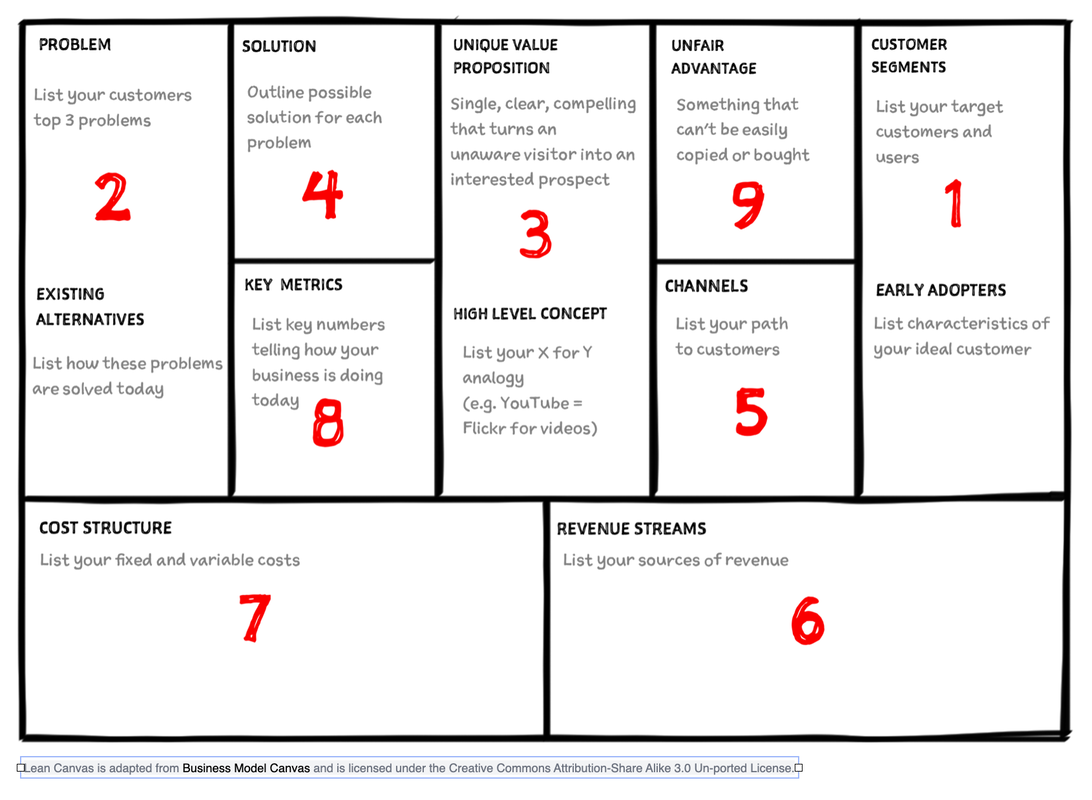|
This is the second part of my posts on filling in the Lean canvas. If you’ve come across this article first, you should take a look at part 1 to begin with. Lean Canvas is a one-page business model template that helps startups decompose their business model quickly. It is part of Ash Maurya’s Continuous Innovation Framework and while on the surface it looks simple, filling it in can be tricky and can lead you in the wrong direction. These posts aim to help you in that respect.
Remember that one of the goals of filling in a lean canvas is to identify your riskiest assumptions and be able to validate if they are correct or if you need to change course. Contents
Unique value proposition As declared by Ash himself, your unique value proposition (UVP). is one of the canvas's most important boxes and the hardest to get right. It is very important for this section to focus on the number one problem you are solving. The UVP is your chance to capture your customer’s attention and your best chance is by addressing their biggest problem. Here’s a crash course on how to craft a good UVP - it must answer “what?”, “who?” and “why?”. There is a lot of advice you can read about UVP but what worked for me was an example, so here’s one: Product: LeaveWizard Headline: Automate leave and absence management to free up time and eliminate friction Sub-headline: LeaveWizard replaces slow and out-dated leave planners with an automated and powerful system that helps you be more productive. High level concept The other part of this box is the high concept pitch. I’ve come across a lot of people struggling with this one. And that’s understandable. After all not everyone is building an obviously genius idea. Unless you’re opening a restaurant, there’s a good chance that most people will struggle to understand what If you’re proposing. If you struggle to come up with something concise and representative for your idea, my suggestion is to leave it for later. However, not too late. Being able to explain your idea to your customers is very important. Sometimes, even good explanations are not sufficient for your customers to see why they should consider using your product. So there is some skill required to make sure people “get it”. Here are some examples that I made up and you might find helpful:
Solution We often refer to our idea and our solution as one and the same thing. I’ve seen countless of founders who are so focused on building their solution that they ignore all warning signs and only realise they’ve built the wrong thing when it’s too late. Your solution is important, which is why it has a box on the canvas but you also need to be prepared to change it depending on what your customers tell you. Your solution is also rarely the riskiest part of your model and identifying our riskiest assumptions is our main goal with the canvas. Sometimes people who have noticed a problem, don’t even have a solution and so this box could remain empty for a while if you’re exploring several options. Very often, people like investors or advisors seem to not care about your solution. This is because they recognise that the solution is a small part of the business model. They are more likely to have questions about customer engagement and market size or opportunity. And last but not least, your customers also don’t care too much about your solution. They will be mainly concerned with solving their problems. That does not mean your solution isn’t important, only that it’s probably not the riskiest part of your plan. In almost all cases your customers will be using an alternative solution to solve their problem. And when your new solution is replacing the alternative, your product will need to offer 3x to 10x improvement over the current alternative in order to cause a switch. And achieving this level of improvement isn’t always easy. However at the initial stages it’s best to only loosely define your solution until you’re certain you understand the problem and that your customers recognise it and would pay for a solution. Here’s an example for your Solution box: Idea/Problem: People who use multiple calendars find it difficult to know when they are really available and if they commit to a specific time slot Solution: Create some sort of calendar events aggregator that is able to consume events from multiple sources and determine when I would be available. Next Steps To keep each piece short I will end the second part here and continue with Channels in the next article in these series on Lean Canvas. If you liked this article please share it with your friends. Feel free to book a chat with me if you'd like some advice on your idea. In the meantime, here are some additional resources about lean canvas: |
Welcome to our blog!About the authorPlamen is a LeanStack coach and an experienced Software Delivery consultant helping organisations around the world identify their path to success and follow it. Archives
May 2024
Categories
All
|


 RSS Feed
RSS Feed
